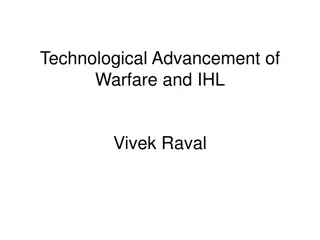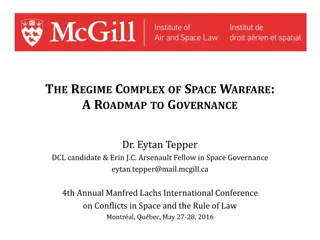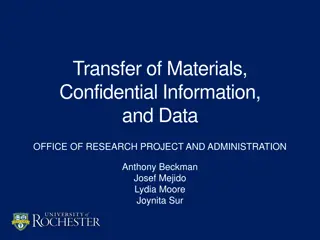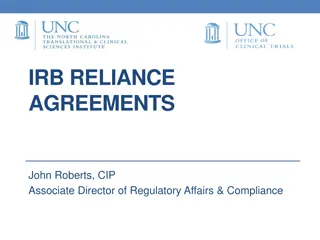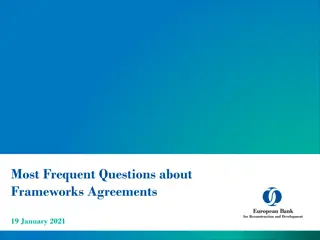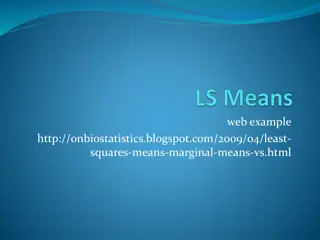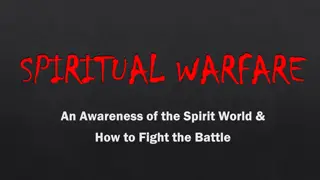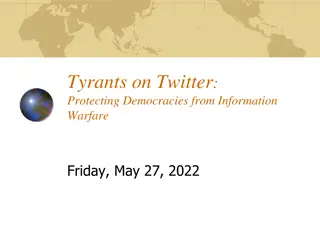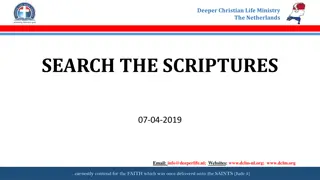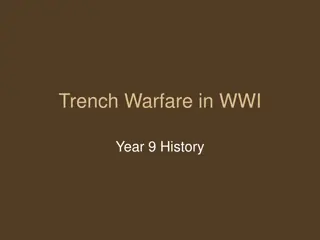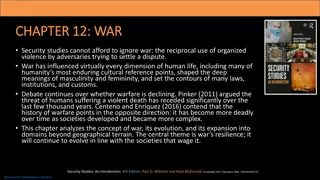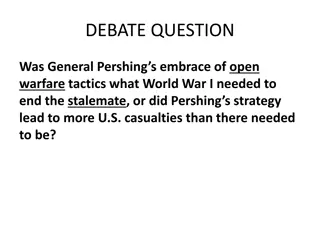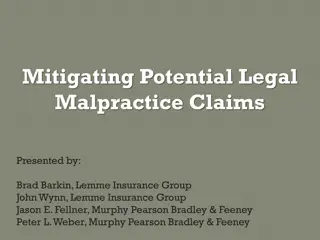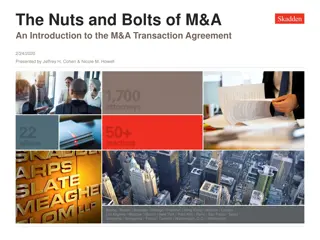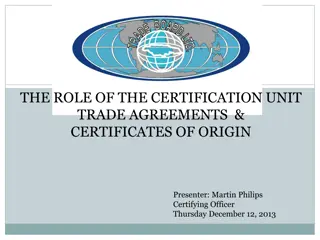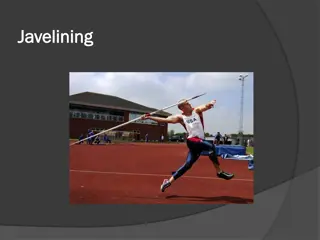International Agreements on Means and Methods of Warfare Throughout History
Explore the evolution of international agreements regulating means and methods of warfare from the 19th century to the present day, focusing on limitations imposed on belligerents to protect civilians and combatants. Various treaties and conventions such as the Hague Conventions, Geneva Conventions, and specific protocols have been established to prohibit the use of certain weapons and tactics in armed conflicts. The Martens Clause reaffirms the protection of individuals in times of war under established principles of international law and humanity. Understanding these agreements is crucial for upholding humanitarian standards in warfare.
- International agreements
- Means and methods of warfare
- Humanitarian law
- Hague Conventions
- Geneva Conventions
Download Presentation

Please find below an Image/Link to download the presentation.
The content on the website is provided AS IS for your information and personal use only. It may not be sold, licensed, or shared on other websites without obtaining consent from the author. Download presentation by click this link. If you encounter any issues during the download, it is possible that the publisher has removed the file from their server.
E N D
Presentation Transcript
Conduct of hostilities Means and methods of warfare Dr. El bieta Mikos-Skuza Seminar Introduction to International Humanitarian Law College of Europe, Natolin, 21st February 2013
International agreements concerning means and methods of warfare 1868 - Declaration Renouncing the Use, in Time of War, of Explosive Projectiles Under 400 Grammes Weight. 1899 - Declaration (IV,3) concerning Expanding Bullets 1899 - Declaration (IV,2) concerning Asphyxiating Gases 1907 - Regulations concerning the Laws and Customs of War on Land. 1907 - Declaration (XIV) Prohibiting the Discharge of Projectiles and Explosives from Balloons 1925 - Protocol for the Prohibition of the Use of Asphyxiating, Poisonous or Other Gases, and of Bacteriological Methods of Warfare 1972 - Convention on the Prohibition of the Development, Production and Stockpiling of Bacteriological (Biological) and Toxin Weapons and on their Destruction. 1977 - Convention on the prohibition of military or any hostile use of environmental modification techniques 1980 - Convention on Prohibitions or Restrictions on the Use of Certain Conventional Weapons Which May be Deemed to be Excessively Injurious or to Have Indiscriminate Effects 1980 - Protocol on Non-Detectable Fragments (Protocol I). 1980 - Protocol on Prohibitions or Restrictions on the Use of Mines, Booby-Traps and Other Devices (Protocol II). 1980 - Protocol on Prohibitions or Restrictions on the Use of Incendiary Weapons (Protocol III) 1995 - Protocol on Blinding Laser Weapons (Protocol IV) 1996 - Protocol on Prohibitions or Restrictions on the Use of Mines, Booby-Traps and Other Devices as amended 2003 - Protocol on Explosive Remnants of War (Protocol V) 1993 - Convention on the prohibition of the development, production, stockpiling and use of chemical weapons and on their destruction 1997 - Convention on the Prohibition of the Use, Stockpiling, Production and Transfer of Anti-Personnel Mines and on their Destruction 2008 Convention on Cluster Munition
Martens Clause Civilians and combatants remained under protection and authority of the principles of international law derived from established custom, from the principles of humanity and from the dictates of public conscience 1899 Hague Convention (Preamble) 1907 Hague Convention (Preamble) 1949 - I-IV Geneva Convention art. 63/62/142/158 1977 - I AP/IIAP art. 1.2/Preamble 1980 - CCW (Preamble)
GENERAL LIMITATION ON THE RIGHT OF BELLIGERENTS TO ADOPT MEANS AND METHODS OF WARFARE ( ) the only legitimate object which States should endeavour to accomplish during war is to weaken the military forces of the enemy ( ) -Saint Petersburg Declaration, 1868 THEREFORE: Art. 22. The right of belligerents to adopt means of injuring the enemy is not unlimited. - Hague Regulation (Hague Convention IV), 1907 Art. 35 -- Basic rules 1. In any armed conflict, the right of the Parties to the conflict to choose methods or means of warfare is not unlimited. - - I AP, 1977
GENERAL RULES ON MEANS AND METHODS OF WARFARE It is particularly prohibited to employ means or methods which are intended or of a nature: -to cause superfluous injury or unnecessary suffering (art,. 23 (e) HagueReg; art. 35, para 2, API) -to injure military objectives, civilians, or civilian objects without distinction (art. 48, art 51, pars. 4 and 5, API) -to cause widespread, longterm, and severe damage to the natural environment (art. 35, para 3, and 55, para 1, API; ENMOD)
Preliminary remarks on the regulation of means of warfare International conflicts Internal conflicts Weapons of mass destructio n Small Arms and light weapon s Conventi onal Weapon s
Types of weapons and ammunition prohibited by IHL Bullets explosive weight, which is either explosive or charged with fulminating or inflammable substances - St. Petersburg Declaration, 1868 bullets which expand or flatten easily in the human body, such as bullets with a hard envelope which does not entirely cover the core or is pierced with incisions (dum-dum bullets) projectiles under 400 grammes - Hague Declaration, 1899
Convention on Prohibitions or Restrictions on the Use of Certain Conventional Weapons Which May be Deemed to be Excessively Injurious or to Have Indiscriminate Effects - (CCW) Protocol on Non-Detectable Fragments - 1980 Protocol on Prohibitions or Restrictions on the Use of Mines, Booby-Traps and Other Devices - 1980 (1996) Protocol on Prohibitions or Restrictions on the Use of Incendiary Weapons - 1980 Protocol on Blinding Laser Weapons - 1995 Protocol on Explosive Remnants of War - 2003
Convention on Anti-Personnel Mines 1997 Prohibition on construction, production,transfer, stockpiling and use Clearance of mine affected areas - 10 years Destruction of stockpiles 4 years Victims assistance (including families and comunities)
Types of weapons and ammunition prohibited by IHL Cluster munition Cluster munition is air-dropped or ground launched weapon that work by dispersing several (bomblets) from a canister, over a wide area to destroy dispersed, moving and unseen targets. smaller submunition Developed in order to improve efficiency of aerial attacks, particularly against soft targets like personnel. Failure rate : 1% - 40%
Types of weapons and ammunition prohibited by IHL Poisons and poisoned weapons it is especially forbidden to employ poison or poisoned weapons, because it has an indiscriminate character and can cause unnecessary suffering - art. 23(a) Hague Regulation; 1907. Prohibition of the use in war asphyxiating, poisonous or other gases, and of all analogous liquids materials or devices - Protocol for the Prohibition of the Use of Asphyxiating, Poisonous or Other Gases, and of Bacteriological Methods of Warfare; 1925.
Types of weapons and ammunition prohibited by IHL Biological and chemical weapons -- prohibition from the use of projectiles the sole object of which is the diffusion of asphyxiating or deleterious gases - II Hague Declaration concerning Gases, 1899 Asphyxiating - prohibition on the use in war of asphyxiating, poisonous or other gases, and of all analogous liquids materials or devices, and extend this bacteriological methods of warfare prohibition on the use of - Geneva Protocol 1925
Types of weapons and ammunition prohibited by IHL Convention on the Prohibition of the Development, Production and Stockpiling of Bacteriological (Biological) and Toxin Weapons and on their Destruction 1972 Prohibition to develop, produce, stockpile or otherwise acquire or retain: 1.microbial or other biological agents, or toxins whatever their origin or method of production, of types and in quantities that have no justification for prophylactic, protective or other peaceful purposes; 2.weapons, equipment or means of delivery designed to use such agents or toxins for hostile purposes or in armed conflict.
Chemical weapons Convention on the prohibition of military or any hostile use of environmental modification December 1976 provide a ban on use of chemical agents causing poisoning people indirectly by having a toxic effect on natural environment techniques, 10 Convention production, stockpiling and use of chemical weapons and on their destruction 1993 (entered into force in 1997) it oblige to destruction of all stockpiles of this weapon and to stop in production Organization for the Prohibition on Chemical Weapons - control over the enforcement of this provisions on the prohibition of the development,
Weapons not prohibited or restricted by binding legal acts of IHL Nuclear weapon no comprehensive and universal prohibition on the use of nuclear weapons in either customary or conventional international law. ICJAdvisory Opinion about the Legality of the threat or use of nuclear weapons - 8 July 1996. o the use of nuclear weapons would generally be contrary to the principles and rules of international humanitarian law (distinction, proportionality etc.) o Court could not reach a definitive conclusion as to the legality or illegality of the use of nuclear weapons by a State in an extreme circumstance of self-defence, in which its very survival would be at stake
Weapons not prohibited or restricted by binding legal acts of IHL Light weapons Small arms portable weapons designed for use by several persons serving as crew, such as heavy machine-guns, mounted grenade-launchers, portable anti-aircraft guns, portable anti-tank guns, portable launchers of anti-tank missiles, and mortars assault rifles, machine guns, hand grenades and designed for military use by an individual combatant, including commercial firearms handguns and hunting rifles. other weapons such as are not in themselves unlawful weapons most small arms have legitimate uses, including for law enforcement and national defence Arms Trade Treaty process
New weapons In the study, development, acquisition or adoption of a new weapon, means or method of warfare, a High Contracting Party is under an obligation to determine whether its employment would, in some or all circumstances, be prohibited by this Protocol or by any other rule of international law applicable to the High Contracting Party - art.36 IAP; 1977
Perfidy Perfidy is prohibited (art. 37, IAP) The term perfidy refers to acts misleading the advers party into the belief that there is a situation affording protection under international law For example: the feigning of an intent to negotiate under a flag of truce or of a surrender; the feigning of an incapacitation by wounds or sickness; the feigning of civilian, non-combatant status; and the feigning of protected status by the use of signs, emblems or uniforms of the United Nations or of neutral or other States not Parties to the conflict
Ruses of war Ruses of war and the employment of measures necessary for obtaining information about the adverse party and the country are permissible (art. 37, para. 2, IAP, art.. 24 HagueReg.) For example: - the use of enemy signals, passwords, signs, decoys etc.
Prohibition on improper use of recognizable emblems of sanitary personnel, cultural property, civil defense, works and installations containing dangerous forces, UN emblems, flag of truce and others It is prohibited to make improper use of flags of truce, enemy or neutral national flags, military insignia and uniforms, acknowledged protective emblems (art. 39 IAP, art.. 23, para. 1 lit f HagueReg.; art. 17 para , CulPropConv) and internationaly For example: - The red cross or the red crescent
Prohibition on giving or ordering no quarter and attacking hors de combat It is prohibited to order that ther shall be no survivors. It is prohibited to threaten an adversary with such an order or to conduct military operations on that basis (art. 40 IAP, art. 23 lit d, HagueReg.) A person who is recognized or who, in the circumstances, should be recognized to be ' hors de combat shall not be made the object of attack (art. 41 IAP)
Espionage Spies are persons who clandestinely, or under fals pretences, e.g. not wearing the uniform of theirarmed forces, gather information on the territory controlled by the adversary. Person who fall into the hands of the adversary while engage in espionage shall be liable to punishment (art. 29-31 HagueReg) Even if captured while engaged in espionage, a spy shall not be punished without prior conviction pursuant to regular judical procedures (art. 30, HagueReg; art. 75, para 4, IAP)
Other methods of warfare Sabotage is allowed by IHL as long as it is directed at military objectives Snipers are permitted only if they attack combatants and military objectives. It is strictly forbidden to threaten civilians by attacking them with snipers.


